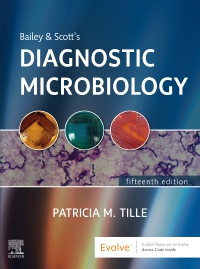
Bailey & Scott's Diagnostic Microbiology - Elsevier eBook on VitalSource, 15th Edition
Elsevier eBook on VitalSource

Now $115.89
**Textbook and Academic Authors Association (TAA) Textbook Excellence Award Winner, 2024**
**Selected for Doody’s Core Titles® 2024 in Laboratory Technology**
Perfect your lab skills with the essential text for diagnostic microbiology! Bailey & Scott’s Diagnostic Microbiology, 15th Edition Is known as the #1 bench reference for practicing microbiologists and as the preeminent text for students in clinical laboratory science programs. With hundreds of full-color illustrations and step-by-step methods for procedures, this text provides a solid, basic understanding of diagnostic microbiology and also covers more advanced techniques such as matrix-assisted laser desorption time-of-flight mass spectrometry. Written by noted CLS educator Dr. Patricia Tille, Diagnostic Microbiology has everything you need to get accurate lab test results in class and in clinical practice.
Newer Edition Available
Bailey & Scott's Diagnostic Microbiology - Elsevier eBook on VitalSource
-
- More than 800 high-quality, full-color illustrations help you visualize concepts.
- Expanded sections on parasitology, mycology, and virology allow you to use just one book, eliminating the need to purchase other microbiology textbooks for these topics.
- Hands-on procedures show exactly what takes place in the lab, including step-by-step methods, photos, and expected results.
- Case studies allow you to apply your knowledge to diagnostic scenarios and to develop critical thinking skills.
- Genera and Species boxes provide handy, at-a-glance summaries at the beginning of each organism chapter.
- Learning objectives at the beginning of each chapter provide measurable outcomes to achieve by completing the chapter material.
- A glossary defines terms at the back of the book and on the Evolve companion website.
-
- New! Updated content includes infectious disease trends and new illustrations such as culture plate images of real specimens, complex gram stains, lactophenol cotton blue microscopy, and more.
- NEW COVID-19 information has been added.
- UPDATED topics include the Human Microbiome Project, expanded MALDI-TOF applications and molecular diagnostics in conjunction with traditional microbiology, additional streps, and significant news in mycology.
- EXPANDED glossary defines terms on the Evolve companion website.
-
PART I: BASIC MEDICAL MICROBIOLOGY
1. Microbial Taxonomy
2. Bacterial Genetics, Metabolism, and Structure
3. Host-Microorganism Interactions
PART II: GENERAL PRINCIPLES IN CLINICAL MICROBIOLOGY
Section 1: Safety and Specimen Management
4. Laboratory Safety
5. Specimen Management
Section 2: Approaches to Diagnosis of Infectious Diseases
6. Role of Microscopy
7. Traditional Cultivation and Identification
8. Nucleic Acid-Based Analytic Methods for Microbial Identification and Characterization
9. Overview of Immunochemical Methods Used for Organism Detection
Section 3: Evaluation of Antimicrobial Activity
10. Principles of Antimicrobial Action & Resistance
11. Laboratory Methods and Strategies for Antimicrobial Susceptibility Testing
PART III: BACTERIOLOGY
Section 1: Principles of Identification
12. Overview of Bacterial Identification Methods and Strategies
Section 2: Catalase-Positive, Gram-Positive Cocci
13. Staphylococcus, Micrococcus, and Similar Organisms
Section 3: Catalase-Negative, Gram-Positive Cocci
14. Streptococcus, Enterococcus, and Similar Organisms
Section 4: Non-Branching, Catalase-Positive, Gram-Positive Bacilli
15. Bacillus and Similar Organisms
16. Listeria, Corynebacterium, and Similar Organisms
Section 5: Non-Branching, Catalase-Negative, Gram-Positive Bacilli
17. Erysipelothirix, Lactobacillus, and Similar Organisms
Section 6: Branching or Partially Acid-Fast, Gram-Positive Bacilli
18. Nocardia, Streptomyces, Rhodococcus, and Similar Organisms
Section 7: Gram-Negative Bacilli and Coccobacilli (MacConkey-Positive, Oxidase-Negative)
19. Enterobacteriaceae
20. Acinetobacter, Stenotrophomonas, and Other Organisms
Section 8: Gram-Negative Bacilli and Coccobacilli (MacConkey-Positive, Oxidase-Positive)
21. Pseudomonas, Burkholderia, and Similar Organisms
22. Achromobacter, Rhizobium, Ochrobactrum, and Similar Organisms
23. Chryseobacterium, Sphingobacterium, and Similar Organisms
24. Alcaligenes, Bordetella (Nonpertussis), Comamonas, and Similar Organisms
25. Vibrio, Aeromonas, Plesiomonas shigelloides, and Chromobacterium violaceum
Section 9: Gram-Negative Bacilli and Coccobacilli (MacConkey-Negative, Oxidase-Positive)
26. Sphingomonas paucimobilis and Similar Organisms
27. Moraxella
28. Eikenella corrodens and Similar Organisms
29. Pasteurella and Similar Organisms
30. Actinobacillus, Kingella, Cardiobacterium, Capnocytophaga, and Similar Organisms
Section 10: Gram-Negative Bacilli and Coccobacilli (MacConkey-Negative, Oxidase-Variable)
31. Haemophilus
Section 11: Gram-Negative Bacilli that are Optimally Recovered on Special Media
32. Bartonella and Afipia
33. Campylobacter, Arcobacter, and Helicobacter
34. Legionella
35. Brucella
36. Bordetella pertussis and Bordetella parapertussis
37. Francisella
38. Streptobacillus moniliformis and Spirillum minus
Section 12: Gram-Negative Cocci
39. Neisseria and Moraxella catarrhalis
Section 13: Anaerobic Bacteriology
40. Overview and General Considerations
41. Overview of Anaerobic Organisms
Section 14: Mycobacteria and Other Bacteria with Unusual Growth Requirements
42. Mycobacteria
43. Obligate Intracellular and Nonculturable Bacterial Agents
44. Cell Wall-Deficient Bacteria: Mycoplasma and Ureaplasma
45. The Spirochetes
PART IV: PARASITOLOGY
46. Overview of the Methods and Strategies in Parasitology
47. Intestinal Protozoa
48. Blood and Tissue Protoza
49. Protozoa from Other Body Sites
50. Intestinal Nematodes
51. Tissue Nematodes
52. Blood and Tissue Filarial Nematodes
53. Intestinal Cestodes
54. Tissue Cestodes
55. Intestinal Trematodes
56. Liver and Lung Trematodes
57. Blood Trematodes
PART V: MYCOLOGY
58. Overview of Fungal Identification Methods and Strategies
59. Hyaline Molds, Zygomycetes, Dermatophytes, and Opportunistic and Systemic Mycoses
60. Dematiaceious Molds
61. Opportunistic Atypical Fungus: P. jiroveci
62. The Yeasts
63. Antifungal Susceptibility Testing, Therapy and Prevention
PART VI: VIROLOGY
64. Overview of the Methods and Strategies in Virology
65. Viruses in Human Disease
66. Antiviral Therapy, Susceptibility Testing and Prevention
PART VII: DIAGNOSIS BY ORGAN SYSTEM
67. Bloodstream Infections
68. Infections of the Lower Respiratory Tract
69. Upper Respiratory Tract Infections and Other Infections of the Oral Cavity and Neck
70. Meningitis and Other Infections of the Central Nervous Systems
71. Infections of the Eyes, Ears, and Sinuses
72. Infections of the Urinary Tract
73. Genital Tract Infections
74. Gastrointestinal Tract Infections
75. Skin, Soft Tissue, and Wound Infections
76. Normally Sterile Body Fluids, Bone and Bone Marrow, and Solid Tissues
PART VIII: CLINICAL LABORATORY MANAGEMENT
77. Quality in the Clinical Microbiology Laboratory
78. Infection Control
79. Sentinel Laboratory Response to Bioterrorism
Glossary



 as described in our
as described in our 